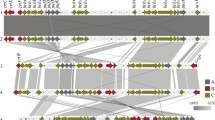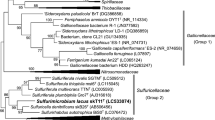Abstract
The metabolic pathways of one-carbon compounds utilized by colorless sulfur bacterium Beggiatoa leptomitoformis D-402 were revealed based on comprehensive analysis of its genomic organization, together with physiological, biochemical and molecular biological approaches. Strain D-402 was capable of aerobic methylotrophic growth with methanol as a sole source of carbon and energy and was not capable of methanotrophic growth because of the absence of genes of methane monooxygenases. It was established that methanol can be oxidized to CO2 in three consecutive stages. On the first stage methanol was oxidized to formaldehyde by the two PQQ (pyrroloquinolinequinone)-dependent methanol dehydrogenases (MDH): XoxF and Mdh2. Formaldehyde was further oxidized to formate via the tetrahydromethanopterin (H4MPT) pathway. And on the third stage formate was converted to CO2 by NAD+-dependent formate dehydrogenase Fdh2. Finally, it was established that endogenous CO2, formed as a result of methanol oxidation, was subsequently assimilated for anabolism through the Calvin–Benson–Bassham cycle. The similar way of one-carbon compounds utilization also exists in representatives of another freshwater Beggiatoa species—B. alba.







Similar content being viewed by others
References
Dubinina G, Savvichev A, Orlova M, Gavrish E, Verbarg S et al (2017) Beggiatoa leptomitoformis sp. nov., the first freshwater member of the genus capable of chemolithoautotrophic growth. Int J Syst Evol Microbiol 67:197–204. https://doi.org/10.1099/ijsem.0.001584
Salman V, Amann R, Girnth A-C, Polerecky L, Bailey JV et al (2011) A single-cell sequencing approach to the classification of large, vacuolated sulfur bacteria. Syst Appl Microbiol 34:243–259. https://doi.org/10.1111/j.1462-2920.2011.02513.x
Strohl WR, Larkin JM (1978) Enumeration, isolation, and characterization of Beggiatoa from freshwater sediments. Appl Environ Microbiol 36:755–770
Grabovich M, Patritskaya V, Muntyan M, Dubinina G (2001) Lithoautotrophic growth of the freshwater strain Beggiatoa D-402 and energy conservation in a homogeneous culture under microoxic conditions. FEMS Microbiol Lett 204:341–345. https://doi.org/10.1111/j.1574-6968.2001.tb10908.x
Teske A, Nelson DC (2006) The genera Beggiatoa and Thioploca. In: Dworkin M, Falkow S, Rosenberg E, Schleifer K-H, Stackebrandt E (eds) The prokaryotes. Springer, New York, pp 784–810
Nelson DC, Castenholz RW (1981) Organic nutrition of Beggiatoa sp. J Bacteriol 147:236–247
Mezzino MJ, Strohl WR, Larkin JM (1984) Characterization of Beggiatoa alba. Arch Microbiol 137:139–144
Orlova MV, Shatsky ND, Belousova EV, Grabovich MY (2016) The ability of freshwater filamentous sulfur bacteria from the family Beggiatoaceae to assimilate molecular nitrogen: molecular detection and expression of nifH—the marker gene of nitrogen fixation. Sorpt Chromatogr Process 16:280–285
Spiridonova EM, Berg IA, Kolganova TV, Ivanovsky RN, Kuznetsov BB et al (2004) A system of oligonucleotide primers for the amplification of the ribulose-1,5-bisphosphate carboxylase/oxygenase genes of different taxonomicgroups of bacteria. Mikrobiologiia 73:316–325
Pfennig N, Lippert KD (1966) Über das vitamin B12-Bedürfnis phototropher Schwefelbakterien. Arch Microbiol 55:425–432
Kuznetsov SI, Dubinina GA (1989) Methods of investigation of aqueous microorganisms. In: Yu I, Sorokin M (eds). Nauka, Moscow
Rabinovich VA, Sherman EE (1964) Modification of method Winkler for analysis of soluble oxygen in small volumes of luquid (in Russian). In: Perfiliev BV (ed) Role of microorganisms in formation of iron-manganese lakustrine ores. Nauka, Moscow, pp 81–86
Fomenkov A, Vincze T, Grabovich M, Dubinina G, Orlova M et al (2015) Complete genome sequence of the freshwater colorless sulfur bacterium Beggiatoa leptomitiformis neotype strain D-402T. Genome Announc. https://doi.org/10.1128/genomeA.01436-15
Aziz RK, Bartels D, Best AA, DeJongh M, Disz T et al (2008) The RAST Server: rapid annotations using subsystems technology. BMC Genom 9:75. https://doi.org/10.1186/1471-2164-9-75
Moriya Y, Itoh M, Okuda S, Yoshizawa AC, Kanehisa M (2007) KAAS: an automatic genome annotation and pathway reconstruction server. Nucleic Acids Res 35:182–185. https://doi.org/10.1093/nar/gkm321
Altschul SF, Gish W, Miller W, Myers EW, Lipman DJ (1990) Basic local alignment search tool. J Mol Biol 215:403–410. https://doi.org/10.1016/S0022-2836(05)80360-2
Carver T, Thomson N, Bleasby A, Berriman M, Parkhill J (2009) DNAPlotter: circular and linear interactive genome visualization. Bioinformatics 25:119–120. https://doi.org/10.1093/bioinformatics/btn578
Lowry OH, Rosenbrough N, Farr A, Randall RJ (1951) Protein measurement with the folin pihenold reagent. J Biol Chem 193:265–275
Hurwitz J, Weissbach A, Horecker BL, Smyrniotis PZ (1956) Spinach phosphoribulokinase. J Biol Chem 218:769–783
Anthony C, Zatman LJ (1967) The microbial oxidation of methanol. Purification and properties of the alcohol dehydrogenase of Pseudomonas sp. M27. Biochem J 104:953–959
Kalyuzhnaya MG, Hristova KR, Lidstrom ME, Chistoserdova L (2008) Characterization of a novel methanol dehydrogenase in representatives of Burkholderiales: implications for environmental detection of methylotrophy and evidence for convergent evolution. J Bacteriol 190:3817–3823. https://doi.org/10.1093/10.1128/JB.00180-08
Egorov AM, Avilova TV, Dikov MM, Popov VO, Rodionov YV et al (1979) NAD+-dependent formate dehydrogenase from methyllotrophic bacterium strain. Purification and characterization. Eur J Biochem 99:569–576
Jewell T, Huston S, Nelson D (2008) Methylotrophy in freshwater Beggiatoa alba strains. Appl Environ Microbiol 74:5575–5578. https://doi.org/10.1128/AEM.00379-08
Chu F, Beck DA, Lidstrom ME (2016) MxaY regulates the lanthanide-mediated methanol dehydrogenase switch in Methylomicrobium buryatense. PeerJ. https://doi.org/10.7717/peerj.2435
Hibi Y, Asai K, Arafuka H, Hamajima M, Iwama T et al (2011) Molecular structure of La3+-induced methanol dehydrogenase-like protein in Methylobacterium radiotolerans. J Biosci Bioeng 111:547–549. https://doi.org/10.1016/j.jbiosc.2010.12.017
Nakagawa T, Mitsui R, Tani A, Sasa K, Tashiro S et al (2012) A catalytic role of XoxF1 as La3+-dependent methanol dehydrogenase in Methylobacterium extorquens strain AM1. PLoS ONE. https://doi.org/10.1371/journal.pone.0050480
Grabovich MYu, Churikova VV, Dubinina GA, Lebedeva VYu (1998) Mixotrophic and lithoheterotrophic growth of the freshwater filamentous sulfur bacterium Beggiatoa leptomitiformis D-402. Microbiology 67:383–388
Trotsenko YuA, Doronina NV, Torgonskaya ML (2010) Aerobic methylobacteria. ONTI PSC RAS, Pushchino
Tamoi M, Ishikawa T, Takeda T, Shigeoka S (1996) Molecular characterization and resistance to hydrogen peroxide of two fructose-1,6-bisphosphatases from Synechococcus PCC 7942. Arch Biochem Biophys 334:27–36. https://doi.org/10.1006/abbi.1996.0425
Acknowledgements
The authors would like to express sincere gratitude to Alexey Fomenkov, Tamas Vincze, Brian P. Anton and Richard J. Roberts for their help with genome sequencing.
Funding
This work was supported by Russian Foundation for Basic Research (Grant 18-04-00556).
Author information
Authors and Affiliations
Corresponding author
Ethics declarations
Conflict of interest
The authors declare that they have no conflict of interest.
Electronic supplementary material
Below is the link to the electronic supplementary material.
Table S1
. The final concentration of additional components in the cultivation medium in different growth conditions. Table S2. Primers used in this work with their annealing temperatures. Table S3. Metabolic genes of Beggiatoa leptomitoformis D-402 that are discussed in the manuscript. Genes are organized based on their relevance to pathways. Table S4. Identity between proteins of two PQQ-dependent dehydrogenases of methanol/ethanol family of B. leptomitoformis D-402 and B. alba and typical methylotrophs. Table S5. Identity between proteins of the Pqq-clusters of B. leptomitoformis D-402 and Methylobacterium extorquens AM1 and Beggiatoa alba B18LD. Table S6. Identity between proteins which take part in formaldehyde oxidation to CO2 of B. leptomitoformis D-402 and Methylobacterium extorquens AM1 and Beggiatoa alba B18LD (PDF 195 kb)
Rights and permissions
About this article
Cite this article
Orlova, M.V., Tarlachkov, S.V., Kulinchenko, E.I. et al. Genomics and Biochemistry of Metabolic Pathways for the C1 Compounds Utilization in Colorless Sulfur Bacterium Beggiatoa leptomitoformis D-402. Indian J Microbiol 58, 415–422 (2018). https://doi.org/10.1007/s12088-018-0737-x
Received:
Accepted:
Published:
Issue Date:
DOI: https://doi.org/10.1007/s12088-018-0737-x




